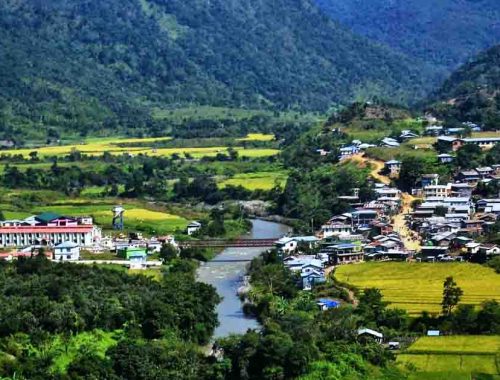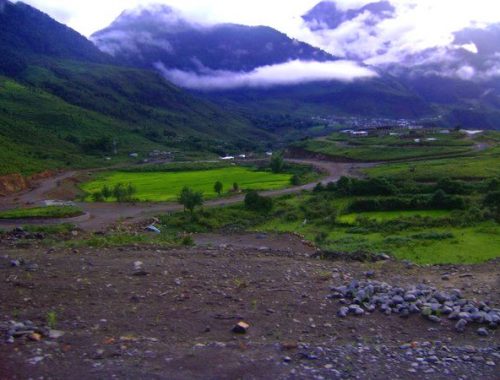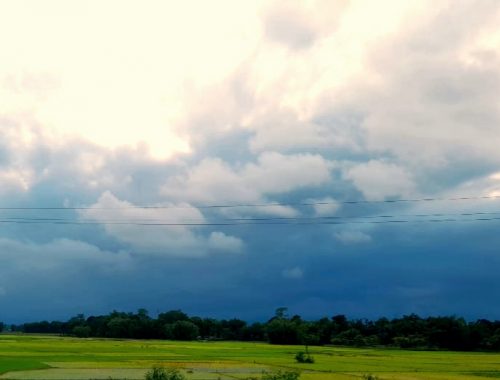Missing from the discourse focussed on Avni however, is the story of how a rising tiger population is forcing the animal to seek out new hunting grounds, as tigers need a huge prey base.” Sarati village in Yavatmal district, Maharashtra, was gripped by fear of Avni. | Photo Credit: S Sudarshan
Was the ‘man-eating’ tigress Avni that was killed in Maharashtra’s Yavatmal district a casualty of rising man-animal conflict, or was some other dynamic at play? Serish Nanisetti on how development projects in tiger habitats and the fragmentation of migration corridors call for a rethink of conservation policies
The modest stretch of forest that’s visible from the roadside is flanked on either side by cotton fields and toor dal (split pigeon pea) crop. A few kilometres away, on the other side of this jungle, in Maharashtra’s Vidarbha region, is National Highway 44 (NH 44). These fields are cultivated by the residents of Sarati village, where the Forest Department has set up a camp to search for a tigress cub. The cub belongs to the litter of T1, or Avni, the tigress that was killed on November 2, 2018 and caused a huge national outcry.
The killing of the tigress may have slipped from public memory. But for many villagers in Wedshi, Vihirgaon, Pimpalshinde, Borati, Ralegaon, Loni, and other villages in Yavatmal district, the terror of the tiger remains real. The media had highlighted the Tipeshwar Wildlife Sanctuary as a hunting ground for the tigress, which had been declared a man-eater. But the tigress, when it was killed, was several kilometres away, in a different forested tract. How the tigress sought out new territory, found a mate, and had a litter in the small deciduous forest surrounded by agricultural fields and villages is still a matter of conjecture for conservationists.
“We began cultivating here in 2003. The forest was right till here [he points to the road]. We cleared it and began cultivating. That was the first time I ever saw a tiger, and I cannot describe the fear I felt,” says Gautam Patil, recalling the day he caught a glimpse of Avni during the monsoons, at the height of the man-eater scare. Patil, a farmer, points to his five-acre field. “This might be a small forest, but we cannot see beyond a few metres during the monsoons. We cannot cultivate anything other than cotton, as wild boars and other animals raid the fields.”
Just three lamp posts away is the house of Gajanan Shyamrao Pawar. He went to his cotton farm abutting the forest to check on his crop on October 24, 2018, and never returned. The 30-year-old’s half-eaten body was later discovered in the jungle by his brother. “He had food at 10 a.m. and went to the farm. He didn’t return for lunch. A goatherd called to say he was missing. We began a search, and his body was found far inside the jungle at around one in the afternoon,” recalls his mother Indukala Pawar, sitting on the doorstep of their small house. Soon after killing Pawar, the tigress had disappeared from the area.
More tigers than before
According to the records of the Principal Chief Conservator of Forests based in Nagpur, the tigress killed three other people — Gulab Mokashe of Wedshi village, Waghu Raut of Vihirgaon, and Nagorao Junghare of Pimpalshinde — in a span of 24 days in August 2018. The Pandharkawada Forest Department records the names of Avni’s other victims: Sonabai Bhosale of Borati, Lakshmi Rampuchrey of Jira, Shankar Atram, Jira, and Chanduk Phutki of Adni. All these villages border the small forest which the tigress had made its territory. A few months later, the tigress was shot dead by the son of a hunter tasked for the job by the Forest Department.
Missing from the discourse focussed on the ‘man-eating’ tigress is the story of how a rising tiger population is forcing the animal to seek out new hunting grounds, as tigers need a huge prey base. Not too long ago, there was a real fear of the big cat’s extinction. But things have changed since. Aided by excellent conservation efforts, more awareness, and forest management and control over poaching, the overall tiger population in the country has gone up.
The 2006 tiger census by the National Tiger Conservation Authority had pegged the number of tigers at 1,411. Officials involved with the 2018 tiger census operations say that the number is now closer to 2,600. “We have completed the tiger census that was begun in 2018, and the analysis is going on. We will release the information by the end of May,” says Y.V. Jhala of the Dehradun-based Wildlife Institute of India, which deployed about 15,000 camera traps spread over 400,000 sq. km in 18 States for the census.
India began a quadrennial scientific tiger census, discarding the old pug mark counting method, from 2006. In 2010, there were 1,706 tigers, and in 2014, the number jumped to 2,226, raising expectations of optimistic numbers for the 2018 census as well.
The surging numbers have pushed the count of tigers to about 400 in Madhya Pradesh, made famous by Rudyard Kipling’s The Jungle Book. But is there land to keep us with this increase? One tiger was mapped travelling from Chandrapur district, bordering the Tadoba-Andhari National Park in Maharashtra, to the Satpura range near Hoshangabad district in Madhya Pradesh. Another tiger, fitted with a tracking collar, was found to have travelled 500 km in 72 days, starting from its habitat in the 138 sq. km Bor Tiger Reserve in Wardha district. It travelled through Amravati and Nagpur before getting electrocuted on a farm in Wardha.
“He bag, waghache panje (see here, the pug marks of a tiger),” says Nilesh Gaddamvar in Marathi, pointing to large pug marks in the dust. Gaddamvar works as a guide at the Tipeshwar Wildlife Sanctuary. Officials say that there are now 18 tigers in the Sanctuary. “We are getting visitors from Kolkata, Hyderabad, Pune and Mumbai. Most of them manage to spot the tiger in its habitat here and take photographs,” says Gaddamvar. He adds that there were only five tigers here in 2011, when he began working as a guide.
Safari visitors usually make a stop at the Hanuman temple located next to a small artificial lake on a ridge in Tipeshwar. The luckier among them might get to see frolicking tigers and cubs a few yards away from the road and their protected vehicles. How the temple came into being and why it is now deserted is a success story of Indian conservation efforts: nearly 500 villagers of Tipeshwar were evacuated and the population resettled outside the forest in Parva village in 2010. Another 140 villagers from Mihirgaon, inside the forest, were paid about ₹7 lakh per family and relocated outside the forest area in 2014.
While these two villages have been pulled out of the forest and resettled, the hamlets on the fringes of the jungle have expanded rapidly. Sarati, which didn’t exist before 2003, has 1,057 voters, Vihirgaon has 719 voters, and Lone, another village where Avni claimed a human life, has 417 voters.
Frequent accidents
On February 2, the Field Director of Pench Tiger Reserve in Maharashtra issued a statement: “A road-hit case of a tiger has been reported near Devalapar, Harnakund, on NH 7, this evening between 7 to 7.30 pm. PTR teams, as well as the team of Nagpur division, have reached the spot. There is a trail of blood, and we have also identified the vehicle. Teams reported that the tiger is nearby, and they have heard growling too. They are monitoring the situation, and a proper decision will be taken as per the local circumstances. The rescue team has left for the spot.” Such reports of road accidents and electrocutions involving tigers are barely noticed beyond a small circle of tiger conservationists and observers.
As a matter of fact, roadkill incidents are quite common on NH 44 (earlier known as NH 7), which passes through some of the most picturesque river valleys, ridges, and forested zones in central India. In this region, NH 44, which connects Srinagar to Kanyakumari, passes through small agricultural fields draped with rows of colourful saris to keep wild boar at bay.
A tiger trap in Mohda village, Madhya Pradesh. | Photo Credit: S Sudarshan
Broken migration corridors
Wildlife conservationists have read the recent rise in the number of tigers as indicating the existence of a broad and long migration corridor — a tongue of land in central India that is changing the tiger story. This tiger corridor is criss-crossed by seasonal rivers such as the Godavari, Wainganga, Penganga, Dollara, and countless other smaller water channels and ravines.
According to officials of the Wildlife Conservation Trust, about 24,000 km of roads cut through these corridors, and they have a deadly impact on tigers. About 16 tigers have been killed in road and train accidents over the past five years. Forty-two leopards have also come under wheels. And no one has been keeping track of the number of smaller mammals such as foxes, rabbits, deer, wolves, snakes, peacocks and other wildlife that die on these roads.
“The problem is that we haven’t yet mapped the tiger corridor, or any of the well-defined routes that the tigers may be using for migration and resettlement. Adding to the confusion is that there are many forest tracts that abut the roads. We want a problem-solving approach to linear intrusions and habitat fragmentation. It is important to work on conservation, but it is also important to work on maintaining connectivity between sub-populations,” explains Milind Pariwakam of the Wildlife Conservation Trust.
Pariwakam had drafted a report on the factors behind the fragmentation of the fragile tiger corridor. The report calls for a rethink of India’s approach to infrastructure development, and recommends special pathways for wildlife so that their movement during migration or resettlement is not affected.
“Tipeshwar is one of the better-maintained forests which visitors can check out. There has been no man-animal conflict here ever since we evacuated the villages from the core area. Places where such conflict occur are more than 40-50 km from Tipeshwar,” says P.B. Panchabhai, District Forest Officer of Pandharkawada in Yavatmal district.
Threat from big projects
“The threat to tigers is not due to the man-animal conflict. It is due to the large-scale projects that are coming up near the sanctuaries. Forest Department officials have trans-located a village called Agarzari on the border of the Pench Tiger Reserve. But the resorts that cropped up there after changes in land use continue to operate. These use barbed wire and electrified fencing to keep animals at bay, leading to accidents,” says Vinod Thakur, a veterinary doctor and conservation activist who was part of the tiger census operation.
He blames the ‘four-laning’ of the national highway running through the Pench Tiger Reserve and Kanha Tiger Reserve, and the widening of the railway line in central India from narrow gauge to broad gauge, for the fragmentation of the habitat. “Even Jai, the tiger which became famous as Asia’s biggest feline, fell to this development juggernaut in the Umred-Karhandla Wildlife Sanctuary. Jai’s cub, Srinivas, died due to electrocution. Jai sired around 20 offspring, but now very few of them are in Umred-Karhandla in Maharashtra. The rest have migrated,” says Thakur.
Big-ticket projects pose an even bigger threat. For instance, according to filings with the Bombay Stock Exchange, the Birla Cement Corporation is planning to set up a 3.9-tonne greenfield integrated cement plant with a 40 MW captive power plant in Yavatmal district’s Mukutban village. Mukutban is on the southern side of the Pandharkawada Forest Department, where man-animal conflict has captured media attention. How a cement plant and the ancillary activities associated with it will affect the environment is anybody’s guess.
Of the 50 designated tiger reserves in the country, the 16 in central India form a continuous tiger corridor. The Tipeshwar Wildlife Sanctuary has about 18 tigers. Kawal, though designated as Kawal Tiger Reserve in 2012, has seen a tiger or two only in the last four years. This year, a tiger got electrocuted after it came in contact with an electrified wire trap set up by poachers. The Umred Karhandla Wildlife Sanctuary, on the other hand, is not a tiger reserve but is home to many tigers. “The Pench Tiger Reserve at present has 30 tigers. While an adult tiger requires 25-40 sq km of forested area to enjoy sufficient quantity of prey, now there is one tiger for every 8-10 sq km, leading to spillage. The tigers are moving out to other forests to find prey. This can be an opportunity to improve our record and practices in wildlife conservation,” says Thakur.
While the killing of Avni triggered celebrations among some villagers, there are also a few who see it differently. “I am unhappy that the tigress is dead. It is a big loss. When the tiger scare was at its peak, I was hopeful that this village would be shifted. The tiger was merely protecting the jungle, which was its home,” says Gunawant Tekam, who runs a small shop near the fields that border the jungle in Sarati. “I am saying this because I have seen the fear of the people as well as the changes in the landscape.”
The depredations of Avni may have grabbed the headlines. But of far greater significance, though missing from the mainstream discourse, is the changing dynamic of tiger migration and movement, which suggests that India needs to rework its conservation and forest settlement policies.l
First Published in The Hindu
_________________________________________________




